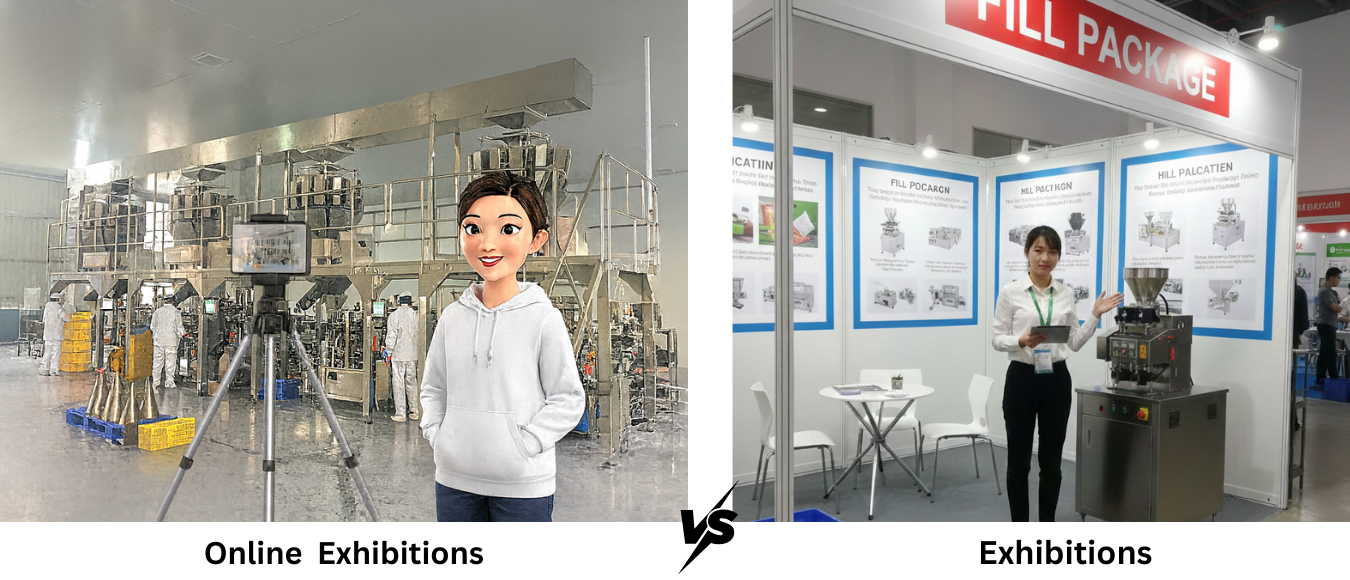During the COVID-19 pandemic, “online exhibitions” became the hottest topic across all industries. With physical channels blocked, nearly every company shifted its focus and resources online. But what were the results?
I can’t speak for fast-moving consumer goods (FMCG), but I can say with certainty that for the packaging equipment industry, the effectiveness of online exhibitions has been far from ideal. From my perspective, the reasons are as follows:
1. The Nature of the Product Limits the Online Model
The inherent characteristics of packaging equipment, as an industrial product, naturally conflict with the model of online showcasing and sales.
- High-Ticket Value: For products of this price point, customer purchasing decisions are extremely deliberate, not impulse buys. They need to conduct comprehensive due diligence, considering factors like brand history, factory establishment date, company scale, after-sales service, case studies, and customer reviews. This complex process is difficult to complete through a few online interactions.
- Strong Need for Physical Experience: It’s like buying a car. Unless it’s a top-tier luxury brand, would you place an order just by watching a livestream? The same logic applies, even more so, to machinery. Customers often need to visit the factory for an inspection or even see the equipment in operation at one of our existing clients’ sites. This is the equivalent of a “test drive” and is an indispensable part of the decision-making chain.
2. A Mismatch with the Mainstream Livestream Market
The behavior of decision-makers for equipo de embalaje also makes them unlikely to be a loyal audience for online exhibitions.
- Decision-Maker Profile: It’s safe to say that over 90% of factory owners or managers with purchasing authority are male, particularly successful professionals over the age of 30. They are extremely busy. They might click on a livestream for a brief moment, but they rarely have the time or patience to watch for an extended period. For them, the time cost of watching a livestream is simply too high.
- The Data-Backed Truth of Livestream E-commerce: Let’s look at the data. According to reports from iiMedia Research and Statista, the mainstream live commerce market is composed of the following:
Product Categories: The top-selling categories are consistently Apparel/Fashion, Beauty & Cosmetics, y Home Goods. For instance, in the Chinese market, home goods accou for a staggering 48.3% of sales. Globally, apparel and fashion dominate the charts. These are all typical B2C consumer goods. Industrial equipment and B2B products are virtually absent from all statistics.
User Demographics: The user base for live shopping is overwhelmingly female (over 64%), with millennials and Gen Y being the primary consumers . This is in stark contrast to the predominantly middle-aged male decision-makers in our industry.
- The Real Audience of a Livestream: Based on this data, we can reasonably conclude that the audience for a packaging equipment livestream is most likely to be: 1) own colleagues; 2) Competitors, curiously gathering intelligence. The number of actual potential customers is negligible.
3. Critical Problems with Livestream Content: What to Say and How to Say It
Beyond audience mismatch, livestreams also suffer from serious content and delivery issues.
•Poor Language Standardization: Livestreams are real-time, and the host’s spoken language often lacks standardization and professionalism. For international customers, if the host’s English pronunciation is unclear or they use too much industry jargon and informal expressions, comprehension becomes extremely difficult. Even if genuine potential customers enter the livestream, they will quickly leave due to language barriers, resulting in a very high bounce rate.
•Severe Content Misalignment: More critically, many companies showcase content during livestreams that they think is important, rather than what customers actually care about. For example: how large the factory is, how impressive the office building looks, how beautifully the showroom is decorated… While these may have some reference value for customers already evaluating suppliers, they are far from what customers most urgently want to know. What customers truly care about is: What problems can your equipment solve for me? How stable is it? What’s the after-sales service like? Do you have successful cases in similar industries? This content misalignment means that even when customers do tune in, effective conversion is unlikely.
My Recommendation: Short-Form Video is a Superior Online Strategy
If livestreams are ineffective, what should our online promotion strategy be? I believe that producing and distributing high-quality, short-form videos is a far more effective strategy than online exhibitions.
The advantages of short videos are:
- No Time Constraints: Customers can watch them during any fragmented moment of their day, which aligns with their efficient work habits.
- Highly Targeted Content: The video content can focus on what customers truly care about, such as:
How to solve a common packaging challenge.
Tips for daily Package machine maintenance.
On-site application cases from a specific industry (e.g., frozen food, pet food).
- Multi-Platform Distribution for Increased Exposure: These videos can be published on multiple professional platforms like YouTube and LinkedIn to continuously attract and nurture potential leads.
•Multilingual Coverage for Precise Market Targeting: This is another major advantage of short videos over livestreams. You can create videos in different languages tailored to specific target markets, such as Spanish (Latin America), Portuguese (Brazil, Portugal), Arabic (Middle East), Russian (Russia and CIS countries), and Korean (South Korea). These videos can be produced with professional voiceovers or subtitles, ensuring high language standardization and accurate information delivery. Combined with content addressing customers’ real concerns, the effectiveness will far exceed single-language livestreams.
An official video introducing the factory scale is necessary, but customers are far more interested in how you can solve their practical problems.
Conclusion: Online is for Support, Offline is the Core
In summary, for the packaging equipment industry, online exhibitions are not a necessity, and it is not worth investing significant effort in them. However, online promotion itself is essential. It should exist as a powerful support tool for offline activities.
Imagine this scenario: A potential customer meets you at a physical trade show and develops an initial interest. When they return to their office and search for your company online, they find a wealth of useful videos showcasing how you solve industry pain points and highlighting customer success stories. This synergy between online and offline efforts will undoubtedly build immense trust and accelerate their decision-making process.
This is purely my personal opinion. What are your thoughts on online versus offline exhibitions for the equipo de embalaje industry? Feel free to leave a comment below.


